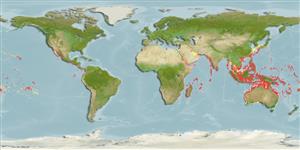Common names from other countries
Classification / Names / Names
Populärnamn | synonymer | Catalog of Fishes (gen., sp.) | ITIS | CoL | WoRMS
Environment: milieu / climate zone / depth range / distribution range
Ekologi
; djupintervall 1 - 56 m (Ref. 100987). Tropical
Indo-Pacific.
Length at first maturity / Size / Vikt / Age
Maturity: Lm ? range ? - ? cm Max length : 7.0 cm SHL hane/ej könsbestämd; (Ref. 349); common length : 5.0 cm SHL hane/ej könsbestämd; (Ref. 349)
Mainly collected for shellcraft because of the highly variable colour patterns of its shell (Ref. 349). Common in subtidal zones (Ref. 349). Also in coral sand of shallow waters (Ref. 799) and muddy sand (Ref. 130068). Members of the family Strombidae are mostly herbivores , browsing on delicate algae, or swallowing sand and detritus to digest the decomposing plant matter (Ref. 349).
Life cycle and mating behavior
Könsmognad | Reproduktion | Lek | Ägg | Fecundity | Larver
Members of the order Neotaenioglossa are mostly gonochoric and broadcast spawners. Life cycle: Embryos develop into planktonic trocophore larvae and later into juvenile veligers before becoming fully grown adults.
Poutiers, J.M. 1998. (Ref. 349)
IUCN Red List Status (Ref. 130435)
Warning: mysqli::__construct(): (08004/1040): Too many connections in C:\Apache24\htdocs\includes\func_getlabel.php on line 46
Can't connect to MySQL database (slbapp). Errorcode: Too many connections
